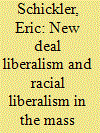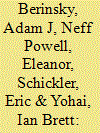| Srl | Item |
| 1 |
ID:
121591


|
|
|
|
|
| Publication |
2013.
|
| Summary/Abstract |
Few transformations have been as important in American politics as the incorporation of African Americans into the Democratic Party over the course of the 1930s-60s and the Republican Party's growing association with more conservative positions on race-related policies. This paper traces the relationship between New Deal economic liberalism and racial liberalism in the mass public. A key finding is that by about 1940, economically-liberal northern white Democratic voters were substantially more pro-civil rights than were economically-conservative northern Republican voters. While partisanship and civil rights views were unrelated among southern whites, economic conservatives were more racially conservative than their economically liberal counterparts, even in the south. These findings suggest that there was a connection between attitudes towards the economic programs of the New Deal and racial liberalism early on, well before national party elites took distinct positions on civil rights. Along with grassroots pressure from African American voters who increasingly voted Democratic in the 1930s-40s, this change among white voters likely contributed to northern Democratic politicians' gradual embrace of civil rights liberalism and Republican politicians' interest in forging a coalition with conservative white southerners. In attempting to explain these linkages, I argue that the ideological meaning of New Deal liberalism sharpened in the late 1930s due to changes in the groups identified with Roosevelt's program and due to the controversies embroiling New Dealers in 1937-38.
|
|
|
|
|
|
|
|
|
|
|
|
|
|
|
|
| 2 |
ID:
110627


|
|
|
|
|
| Publication |
2011.
|
| Summary/Abstract |
Studies of mass political attitudes and behavior before the 1950s have been limited by a lack of high-quality, individual-level data. Fortunately, data from public opinion polls conducted during the late New Deal and World War II periods are available, although the many difficulties of working with these data have left them largely untouched for over 60 years. We compiled and produced readily usable computer files for over 400 public opinion polls undertaken between 1936 and 1945 by the four major survey organizations active during that period. We also developed a series of weights to ameliorate the problems introduced by the quota-sampling procedures employed at the time. The corrected data files and weights were released in May 2011. In this article, we briefly discuss the data and weighting procedures and then present selected time series determined using questions that were repeated on 10 or more surveys. The time series provide considerable leverage for understanding the dynamics of public opinion in one of the most volatile-and pivotal-eras in American history.
|
|
|
|
|
|
|
|
|
|
|
|
|
|
|
|